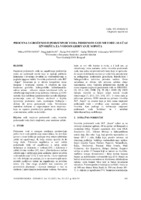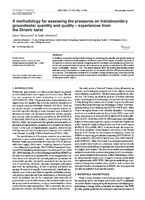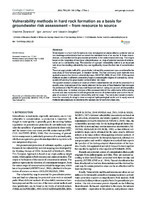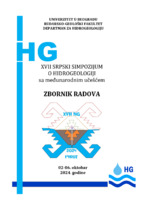Претрага
13 items
-
Процена угрожености подземних вода применом GOD методе: случај изворишта за водоснабдевање Сопота
Милица Степановић, Драгољуб Бајић, Душан Поломчић, Стефан Шикман, Александар Новитовић . "Процена угрожености подземних вода применом GOD методе: случај изворишта за водоснабдевање Сопота" in Водопривреда, Београд : Српско друштво за наводњавање и одводњавање (2021) М51
-
Ocena ranjivosti podzemnih voda od zagađenja na primerima karsta Srbije
Vladimir ŽIVANOVIĆ (2011)Vladimir ŽIVANOVIĆ. Ocena ranjivosti podzemnih voda od zagađenja na primerima karsta Srbije, Beograd:Rudarsko-geološki fakultet, 2011
-
A methodology for assessing the pressures on transboundary groundwater quantity and quality – experiences from the Dinaric karst
Zoran Stevanović, Veljko Marinović (2020)A relatively novel and abridged methodology for assessing the quantity and quality status of groundwater bodies has been applied in the Dinaric karst of SE Europe. Validation of pressure on quantity is based on groundwater budgeting and the correlation of available groundwater reserves and projected water demands, while pressure on quality is estimated by GIS-created maps: vulnerability – hazard – risk. The results obtained from the studied groundwater bodies indicate mostly low pressure on water quantity, but increased risk from diffuse and point pollution sources. ...Zoran Stevanović, Veljko Marinović. "A methodology for assessing the pressures on transboundary groundwater quantity and quality – experiences from the Dinaric karst" in Geologia Croatica, Croatian Geological Survey (2020). https://doi.org/10.4154/gc.2020.08 М23
-
Prirodna ranjivost karstnih izdani srednjetrijaskih krečnjaka u oblasti između reka Bistrice, Uvca i Lima
Branislav Petrović, Veljko Marinović, Zoran Stevanović. "Prirodna ranjivost karstnih izdani srednjetrijaskih krečnjaka u oblasti između reka Bistrice, Uvca i Lima" in 18. Kongres geologa Srbije, Srpsko geološko društvo (2022) М64
-
Environmental flows and demands for sustainable water use in protected karst areas of the Western Balkans
Karst terrains cover some 30% of the Western Balkans, where rich karst aquifers represent the main source of potable water supply and ensure the development of local economies and tourism. In this “classical karst” region, there are also numerous sites or areas under different forms of protection—from those that are included in the UNESCO World Heritage list to natural monuments and landscapes that are protected by national legislation. In and around them are specific representatives of flora and fauna ...Zoran Stevanović, Aleksandra Maran Stevanović, Želimir Pekaš, Romeo Eftimi, Veljko Marinović. "Environmental flows and demands for sustainable water use in protected karst areas of the Western Balkans" in Carbonates and Evaporites, Springer Science and Business Media LLC (2021). https://doi.org/10.1007/s13146-021-00754-1 М22
-
Environmental flows and demands for sustainable water use in protected karst areas of the Western Balkans
Karst terrains cover some 30% of the Western Balkans, where rich karst aquifers represent the main source of potable water supply and ensure the development of local economies and tourism. In this “classical karst” region, there are also numerous sites or areas under different forms of protection—from those that are included in the UNESCO World Heritage list to natural monuments and landscapes that are protected by national legislation. In and around them are specific representatives of flora and fauna ...Zoran Stevanović, Aleksandra Maran Stevanović, Želimir Pekaš, Romeo Eftimi, Veljko Marinović. "Environmental flows and demands for sustainable water use in protected karst areas of the Western Balkans" in Carbonates and Evaporites, Springer Science and Business Media LLC (2022). https://doi.org/10.1007/s13146-021-00754-1 М22
-
CC-PESTO: a novel GIS-based method for assessing the vulnerability of karst groundwater resources to the effects of climate change
The new GIS-based CC-PESTO method is shown to successfully assess and map the vulnerability/resilience of karst aquifers to effects of climate change. Karst aquifers were chosen due to their importance at the global level and widespread utilisation in potable water supply and irrigation, but also because of their hydrogeological complexity. The method was developed to assess the intrinsic vulnerability of aquifers, without considering the direct impact of variable climate factors, but considering the adaptive capacity of aquifers in response ...Zoran Stevanović, Veljko Marinović, Jelena Krstajić. "CC-PESTO: a novel GIS-based method for assessing the vulnerability of karst groundwater resources to the effects of climate change" in Hydrogeology Journal, Springer Science and Business Media LLC (2020). https://doi.org/10.1007/s10040-020-02251-6 М21
-
Transboundary groundwater resource management: needs for monitoring the Cijevna River Basin (Montenegro–Albania)
The transboundary Cijevna River Basin shared between Albania and Montenegro has a surface area of 650 km2. It is extremely important for water management, especially in the country of Montenegro which is downstream. Due to the high permeability of both the karst and intergranular aquifers that exist in the basin, the River Cijevna sinks along the length of its riverbed and in summer months it usually dries up completely at the confluence section. Hydrometry surveys undertaken during a drought ...Upravljanje međugraničnim vodama, ranjivost podzemnih voda, monitoring mreža, karstne izdani, Albanija, Crna GoraMomčilo Blagojević, Zoran Stevanović, Milan Radulović, Veljko Marinović, Branislav Petrović. "Transboundary groundwater resource management: needs for monitoring the Cijevna River Basin (Montenegro–Albania)" in Environmental Earth Sciences, Springer Science and Business Media LLC (2020). https://doi.org/10.1007/s12665-020-8809-8 М22
-
Groundwater vulnerability assessment as a tool for understanding karst flow systems and prediction of spring yield - case example of a karst spring in Western Serbia
Modelling approaches in karst hydrogeology imply a high degree of schematization, uncertainty and subjectivity due to the specific nature of karst systems. The need to protect groundwater, especially in karst, has resulted in increasing application of methods for assessing groundwater vulnerability. Vulnerability methods specially developed for karst could assess filtration conditions, anisotropy, specific infiltration, and temporal variability, enabling better characterization and understanding of the karst systems. A recently developed method is the Time Dependent Model (TDM method), where vulnerability ...Vladimir Živanović, Nebojša Atanacković, Slavko Špadijer. "Groundwater vulnerability assessment as a tool for understanding karst flow systems and prediction of spring yield - case example of a karst spring in Western Serbia" in IAH 2024 World Groundwater Congress - Interacting Groundwater, Davos, Švajcarska, 08-13.09.2024, Centre for Hydrogeology and Geothermics (CHYN), UNINE (2024) М34
-
Vulnerability methods in hard rock formation as a basis for groundwater risk assessment – from resource to source
Groundwater in a hard rock formation is most endangered at places where a potential source can discharge contaminants that can reach the saturated zone of an aquifer. In these circumstances, an essential tool for groundwater protection is the contamination risk map. This map is based on the integration of two maps: a hazards map, i.e., map of potential sources of contamination and a vulnerability map. The selection of a proper vulnerability method is an important task since the resulting ...karta rizika od kontaminacije, ranjivosti podzemnih voda, DRASTIC, EPIK, PI, COP, Nacionalni park TaraVladimir Živanović, Igor Jemcov, Veselin Dragišić. "Vulnerability methods in hard rock formation as a basis for groundwater risk assessment – from resource to source" in Geologia Croatica, Croatian Geological Survey (2022). https://doi.org/10.4154/gc.2022.23 М23
-
Validation of vulnerability assessment by means of the Time Dependent, Model: case study from the Slovenian karst catchment
Groundwater vulnerability assessment methods are continuously being developed and existing methods are very often modified to provide better simulation of natural protection conditions and more objective results. Most frequently used methods are based on calculation of predefined parameters influencing water infiltration and underground flow, which can often lead to bias conclusions related to vulnerability evaluations. Some other methods, like the Time Dependent Model (TDM) are based on an approach, where parametrization is obtained at the final stage of the ...Ocena ranjivosti podzemnih voda, karstne podzemne vode, TDM metoda, delineacija sanitarnih zona, Slovenački karstVladimir Živanović, Nataša Ravbar, Igor Jemcov. "Validation of vulnerability assessment by means of the Time Dependent, Model: case study from the Slovenian karst catchment" in Proceedings of IAH2019, the 46th Annual Congress of the International Associaton of Hydrogeologists, Málaga (Spain), September 22-27, 2019, International Association of Hydrogeologists (IAH) (2019) М34
-
Analiza uslova zaštite užičkih vrela primenom TDM metode za ocenu ranjivosti podzemnih voda
Vladimir Živanović, Slavko Špadijer (2024)Definisanje uslova zaštite podzemnih voda u karstnim terenima predstavlja kompleksan i multidisciplinaran zadatak koji zahteva upotrebu savremenih hidrogeoloških metoda. Metode za ocenu ranjivosti podzemnih voda kod kojih se ranjivost definiše na bazi vremena kretanja podzemnih voda mogu značajno da pomognu u delineaciji sanitarnih zona. Primenom ovih metoda se detaljno analiza zaštitna uloga nadizdanske zone tako se preventivne mere mogu usmeriti ka područjima gde su podzemne vode najranjivije i gde najlakše može doći do kontaminacije. Metode za ocenu ranjivosti podzemnih ...uslovi zaštite podzemnih voda, TDM metoda, ranjivost izvorišta podzemnih voda, karstna izdan, užička vrelaVladimir Živanović, Slavko Špadijer. "Analiza uslova zaštite užičkih vrela primenom TDM metode za ocenu ranjivosti podzemnih voda" in XVII Srpski simpozijum o hidrogeologiji sa međunarodnim učešćem , Pirot, Srbija 02-06. oktobar 2024, Beograd : Univerzitet u Beogradu - Rudarsko-geološki fakultet (2024). https://doi.org/10.5281/zenodo.13739864 М33
-
Postojeće stanje i budući trendovi u preventivnoj zaštiti podzemnih voda Srbije
Vladimir Živanović (2022)Podzemne vode predstavljaju osnovni, a u mnogim zemljama i jedini resurs za javno vodosnabdevanje stanovništva tako da zaštita podzemnih voda predstavlja bitan preduslov za njihovo dugotrajno i održivo korišćenje. Kako u svetu, tako i u Srbiji, zaštita podzemnih voda se najvećim delom svodi na primenu preventivnih mera zaštite. Kod planiranja zaštite većih prostora sve više se koriste metode za ocenu ranjivosti podzemnih voda. Njihova primena je posebno naglašena u karstnim područjima zato što se tu izdvajaju delovi terena sa ...Zaštita podzemnih voda, karte ranjivosti podzemnih voda, karta hazarda, karte rizika od kontaminacije, monitoring podzemnih voda, SrbijaVladimir Živanović. "Postojeće stanje i budući trendovi u preventivnoj zaštiti podzemnih voda Srbije" in Zbornik radova XVI srpskog Simpozijum o hidrogeologiji sa međunarodnim učešćem, Univerzitet u Beograd, Rudarsko-geološki fakultet (2022) М31







